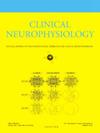1型神经纤维瘤病的高分辨率神经超声:一项前瞻性和描述性研究
IF 3.6
3区 医学
Q1 CLINICAL NEUROLOGY
引用次数: 0
摘要
目的探讨高分辨率神经超声(HRUS)和神经传导检查(NCS)在1型神经纤维瘤病(NF1)丛状神经纤维瘤(PNs)筛查中的价值。6方法纳入成年NF1患者。患者分为两组:有周围神经系统相关症状(PNS7组)和无pns相关症状(非pns组)。研究访视包括神经学检查、NCS和HRUS。结果共纳入60例患者,其中PNS组37例,非PNS组23例。HRUS异常52例(87%),PNS组34例(92%),非PNS组18例(78%,p = 0.24)。持续神经扩张(高PN肿瘤负荷)的患者很容易用HRUS区分。85%的NCS正常患者在HRUS上有神经扩张。结论shrus有助于评估NF1患者PN肿瘤负荷。NCS没有附加价值。hrus作为NF1患者PN的筛查工具可能是有用的,特别是在MRI可用性较低的情况下。本文章由计算机程序翻译,如有差异,请以英文原文为准。
High resolution nerve ultrasound in neurofibromatosis type 1: a prospective and descriptive study
Objective
To explore the value of high resolution nerve ultrasound (HRUS)3 and nerve conduction studies (NCS)4 in screening for plexiform neurofibromas (PNs)5 in neurofibromatosis type 1 (NF1).6
Methods
Adult patients with NF1 were eligible. Patients were divided into two groups: with peripheral nervous system related symptoms (PNS7 group) and without PNS-related symptoms (non-PNS group). Study visit included neurological examination, NCS and HRUS.
Results
Sixty patients were enrolled, 37 in the PNS group and 23 in the non-PNS group. HRUS was abnormal in 52 patients (87 %), 34 in the PNS group (92 %) and 18 in the non-PNS group (78 %, p = 0.24). Patients with continuous nerve enlargements (high PN tumor load) were easily distinguished with HRUS. 85 % of patients with normal NCS have nerve enlargements on HRUS.
Conclusions
HRUS helps to assess PN tumor burden in NF1. NCS did not have additional value.
Significance
HRUS might be useful as a screening tool for PN in NF1, especially in settings with less MRI availability.
求助全文
通过发布文献求助,成功后即可免费获取论文全文。
去求助
来源期刊

Clinical Neurophysiology
医学-临床神经学
CiteScore
8.70
自引率
6.40%
发文量
932
审稿时长
59 days
期刊介绍:
As of January 1999, The journal Electroencephalography and Clinical Neurophysiology, and its two sections Electromyography and Motor Control and Evoked Potentials have amalgamated to become this journal - Clinical Neurophysiology.
Clinical Neurophysiology is the official journal of the International Federation of Clinical Neurophysiology, the Brazilian Society of Clinical Neurophysiology, the Czech Society of Clinical Neurophysiology, the Italian Clinical Neurophysiology Society and the International Society of Intraoperative Neurophysiology.The journal is dedicated to fostering research and disseminating information on all aspects of both normal and abnormal functioning of the nervous system. The key aim of the publication is to disseminate scholarly reports on the pathophysiology underlying diseases of the central and peripheral nervous system of human patients. Clinical trials that use neurophysiological measures to document change are encouraged, as are manuscripts reporting data on integrated neuroimaging of central nervous function including, but not limited to, functional MRI, MEG, EEG, PET and other neuroimaging modalities.
 求助内容:
求助内容: 应助结果提醒方式:
应助结果提醒方式:


